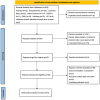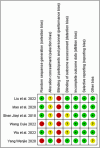Efficacy of Action Observation Therapy on Cognitive Function in Stroke: A Systematic Review and Meta-Analysis
- PMID: 40259717
- PMCID: PMC12012254
- DOI: 10.1002/brb3.70474
Efficacy of Action Observation Therapy on Cognitive Function in Stroke: A Systematic Review and Meta-Analysis
Abstract
Introduction: Action Observation Therapy (AOT) is a rehabilitation method believed to activate the mirror neuron system, which may contribute to cognitive recovery. Previous studies have shown varying results due to different intervention characteristics. This review will examine the efficacy of AOT on clinical cognitive function in stroke.
Methods: Randomized controlled trials (RCTs) comparing AOT with non-AOT interventions in cognitive function were included. Databases searched included PubMed, Cochrane Library, Embase, Web of Science, EBSCO, CNKI, WanFang, and VIP database from inception to May 6, 2024. The risk of bias was assessed using Cochrane's Risk of Bias Assessment Tool 2.0, and the quality of evidence was evaluated with the GRADE approach. RevMan 5.4 and Stata 18.0 were used for the meta-analysis. After the analysis of cognitive function, meta-regression was performed to explore the possible sources of heterogeneity. A random-effects meta-analysis model using the inverse-variance and Hartung-Knapp methods was used to calculate pooled estimates and 95% confidence interval (CI) values. We examined the funnel plot and used Egger's regression test to assess for publication bias. This study was conducted by PRISMA reporting guidelines (Appendix S1). The search protocol was prospectively registered in PROSPERO (CRD42024571694).
Results: A total of 6 RCTs with 400 participants were included. All the included articles were rated as having B-level quality. Meta-analysis showed that AOT significantly improved cognitive function in stroke. Meta-regression did not find the source of heterogeneity. The GRADE result indicated that the finding was of very low certainty.
Conclusions: Cognitive interventions based on AOT can improve cognitive function in stroke patients. However, it should be interpreted cautiously due to heterogeneity and low certainty. To strengthen evidence-based practices, we advocate for higher-quality and more homogeneous RCTs, including strict randomization procedures, large sample sizes, extended follow-up periods, and studies focused on specific disease subtypes.
Keywords: Action Observation Therapy; cognitive function; meta‐analysis; stroke.
© 2025 The Author(s). Brain and Behavior published by Wiley Periodicals LLC.
Figures







Similar articles
-
Yoga for stroke rehabilitation.Cochrane Database Syst Rev. 2017 Dec 8;12(12):CD011483. doi: 10.1002/14651858.CD011483.pub2. Cochrane Database Syst Rev. 2017. PMID: 29220541 Free PMC article.
-
Systemic pharmacological treatments for chronic plaque psoriasis: a network meta-analysis.Cochrane Database Syst Rev. 2017 Dec 22;12(12):CD011535. doi: 10.1002/14651858.CD011535.pub2. Cochrane Database Syst Rev. 2017. Update in: Cochrane Database Syst Rev. 2020 Jan 9;1:CD011535. doi: 10.1002/14651858.CD011535.pub3. PMID: 29271481 Free PMC article. Updated.
-
Systemic pharmacological treatments for chronic plaque psoriasis: a network meta-analysis.Cochrane Database Syst Rev. 2021 Apr 19;4(4):CD011535. doi: 10.1002/14651858.CD011535.pub4. Cochrane Database Syst Rev. 2021. Update in: Cochrane Database Syst Rev. 2022 May 23;5:CD011535. doi: 10.1002/14651858.CD011535.pub5. PMID: 33871055 Free PMC article. Updated.
-
Systemic pharmacological treatments for chronic plaque psoriasis: a network meta-analysis.Cochrane Database Syst Rev. 2020 Jan 9;1(1):CD011535. doi: 10.1002/14651858.CD011535.pub3. Cochrane Database Syst Rev. 2020. Update in: Cochrane Database Syst Rev. 2021 Apr 19;4:CD011535. doi: 10.1002/14651858.CD011535.pub4. PMID: 31917873 Free PMC article. Updated.
-
Virtual reality for stroke rehabilitation.Cochrane Database Syst Rev. 2025 Jun 20;6(6):CD008349. doi: 10.1002/14651858.CD008349.pub5. Cochrane Database Syst Rev. 2025. PMID: 40537150 Free PMC article.
References
Publication types
MeSH terms
Grants and funding
LinkOut - more resources
Full Text Sources
Medical

